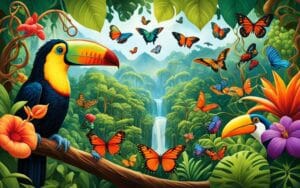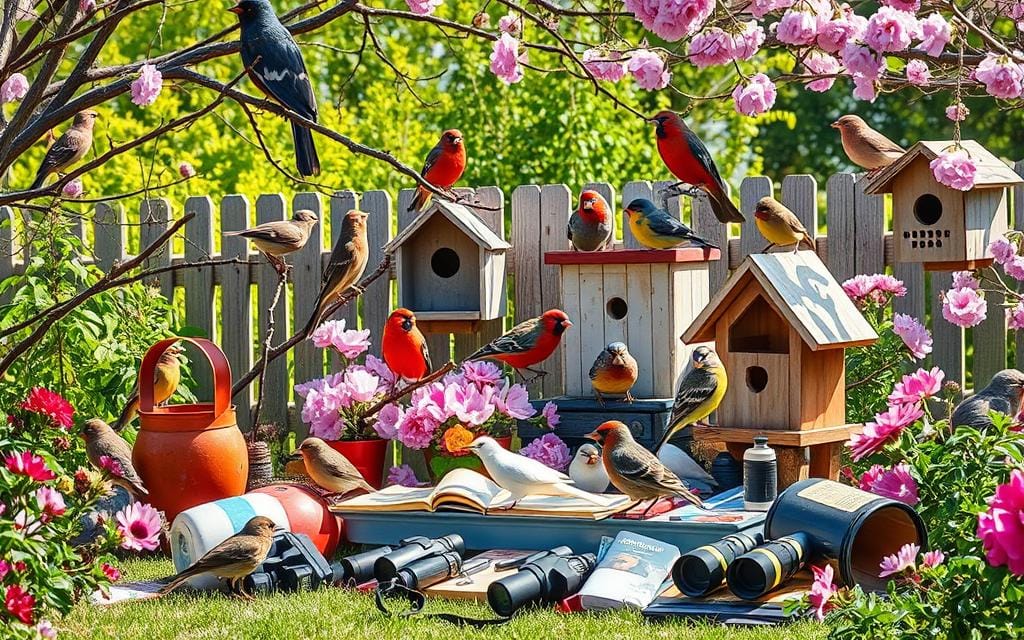Difference Between Jungle and Rainforest – In the vast world of nature, “jungle” and “rainforest” are often used together. But they are not the same. This article will show you the main differences between jungles and rainforests. We’ll look at their unique features, habitats, and why knowing the difference is important.
We’ll start by defining what a jungle is and what makes it special. Then, we’ll explore rainforests and their unique ecosystems. By learning about each, we can value the diversity of our planet and the need to protect these environments.
Table of Contents
ToggleWhat is a Jungle?
When we think of lush, dense vegetation, the term “jungle” often comes to mind. Jungles are captivating environments found in tropical and subtropical regions around the world. These verdant landscapes are characterized by their thick foliage, high humidity, and abundant wildlife.
Defining the Characteristics of a Jungle
Jungles are defined by several key characteristics:
- Dense, tangled vegetation with a diverse array of plant species
- High levels of humidity and precipitation, often due to their proximity to the equator
- A multilayered canopy that blocks out a significant amount of sunlight
- Teeming with a wide variety of animal life, from large predators to small insects
- Nutrient-rich soil that supports rapid plant growth
These traits create a unique and dynamic ecosystem that supports an incredible diversity of life.
Common Misconceptions About Jungles
Despite their prevalence in popular culture, there are several common misconceptions about jungles:
- Jungles are not the same as rainforests – while they share some similarities, jungles and rainforests are distinct ecosystems with their own unique characteristics.
- Not all jungles are located in the Amazon – jungles can be found in various tropical regions around the world, such as Southeast Asia and Central Africa.
- Jungles are not always lush and green year-round – some jungles experience distinct dry seasons that can lead to a temporary loss of foliage.
Understanding the true nature of jungles is crucial to appreciating their complexity and importance in the natural world.
What is a Rainforest?
Rainforests are lush, green forests found in tropical or subtropical areas worldwide. They are known for their high rainfall and support a wide variety of plants and animals. These forests are crucial for our planet’s ecosystem balance.
Understanding the Unique Ecosystem of Rainforests
Rainforests have a diverse and interconnected ecosystem. The warm temperatures, high rainfall, and plenty of sunlight make it perfect for many plants and animals. Every part of the rainforest, from the tall trees to the undergrowth, is vital for its health.
- Rainforests have a layered canopy, supporting many species.
- The dense foliage and humidity create a special microclimate, perfect for certain organisms.
- Nutrient cycling is key in rainforests, quickly making soil rich with nutrients.
- Rainforest ecosystems are sensitive to changes and human actions.
Learning about the characteristics of rainforests helps us understand their importance. By studying these environments, we learn about the connections between all living things. This knowledge is crucial for protecting these natural treasures.
Key Difference Between Jungle and Rainforest
Jungles and rainforests share some things but are quite different. They vary in climate, weather, and the variety of life they support. Knowing these differences helps us value these unique places more.
Climate and Weather Patterns
Jungles are in the tropics and have a hot, humid climate with little temperature change. Rainforests can be in both tropical and temperate areas. They have steady rain, high humidity, and moderate temperatures.
Biodiversity and Species Diversity
Rainforests are known for their huge variety of plants and animals. Jungles also have a lot of life but not as many different species as rainforests. This is because jungles have changing conditions that make some species more specialized.
Knowing how jungles and rainforests differ helps us see their special qualities. By understanding these differences, we learn more about the complex ecosystems that support life on Earth.
Vegetation and Plant Life
Jungles and rainforests are known for their rich plant life. They share some similarities but also have their own unique features. Let’s dive into the world of plants in these amazing places.
Jungles have a dense, tangled layer of plants under the trees. Many plant species compete for sunlight, which filters down. They have evolved to live in low light, with long leaves to catch as much sunlight as possible. You’ll see ferns, vines, shrubs, and tall trees in the jungle.
Rainforests, on the other hand, have a layered canopy that supports a wide variety of plants. From tall trees that reach the sky to plants that grow on other plants, rainforests are full of life. This layered structure lets many plant species live together, each in its own special spot.
| Characteristic | Jungle | Rainforest |
|---|---|---|
| Understory | Dense and tangled | Layered and diverse |
| Canopy Structure | Less defined | Highly stratified |
| Plant Diversity | Moderate to High | Extremely High |
The plants in jungles and rainforests are key to their ecosystems. They provide shade, food, and homes for many creatures. These plants are the base of life in these places.

Animal Life and Habitats
Jungles and rainforests are full of different animals, each with its own special species. We’ll look at the amazing ways these animals live in their lush homes. They have unique adaptations and behaviors that help them survive.
Unique Animal Species in Jungles and Rainforests
In the world’s jungles, you’ll find amazing animals like big cats and colorful birds. The Malayan tiger, Asian elephant, and Sumatran rhinoceros live here. Rainforests have their own special animals, like the jaguar, macaws, and giant otter.
Some animals live in both jungles and rainforests. But many are only found in one place. The rainforest’s tall trees and lots of food support many animals. Jungles have different animals that like the open spaces and varied land.
Animals in jungles and rainforests are key to their ecosystems. From big predators to tiny insects, each one helps keep the environment healthy and full of life.
Geographical Distribution and Locations
Jungles and rainforests are found all over the world. They thrive in places with the right climate, rainfall, and terrain. These factors help decide where these lush areas can grow.
Jungles are mostly in the tropics near the equator. You’ll find the most in Central and South America, Central Africa, and Southeast Asia. These places are warm, humid, and get a lot of rain, perfect for jungle plants.
Rainforests are also in the tropics but spread out more. The Amazon rainforest in South America is the biggest and most famous. Other big ones are in Central Africa, Indonesia, and Australia.
| Region | Jungles | Rainforests |
|---|---|---|
| Central and South America | Amazon Basin, Central American jungles | Amazon rainforest, Atlantic Forest, Orinoco Delta |
| Central Africa | Congo Basin, Equatorial Guinea | Congo Basin rainforest |
| Southeast Asia | Malay Peninsula, Borneo, Sumatra | Sundaic rainforest, Kalimantan rainforest |
| Australia | N/A | Wet Tropics of Queensland |
Jungles and rainforests are similar but different in where they grow. Their locations depend on the climate and environment of each place.
The Importance of Preserving Jungles and Rainforests
Our planet’s jungles and rainforests are key to keeping our ecosystems balanced. They are not just beautiful but also important for fighting climate change. By saving these areas, we help future generations have a healthier world.
These places are full of different plants and animals, many we haven’t found yet. They give us things like wood, medicines, and water. Keeping them safe helps protect the life they support.
Jungles and rainforests also help control the water cycle, affecting rainfall and climate. Saving them means we keep clean water for communities that need it.
Preserving jungles and rainforests is very important. By protecting them, we help our planet, support local communities, and keep life diverse.
We must take care of the Earth by saving jungles and rainforests. We can do this with sustainable actions, research, and working together. This way, these important places can keep supporting life on Earth.
Conclusion
We’ve looked into jungles and rainforests, showing they’re not the same. They have their own special features. Here are the main points:
Jungles are dense, full of tangled trees, mostly in the tropics. They have both deciduous and evergreen trees. Rainforests, on the other hand, are full of tall, evergreen trees. They are home to many plants and animals. Jungles are found in certain areas, while rainforests cover a larger part of the world.
It’s important to protect these areas. They support a huge variety of life and help control our planet’s climate. By understanding the differences between jungles and rainforests, we can see how precious our natural world is. This helps us work to protect it for the future.
FAQ
What is the difference between a jungle and a rainforest?
Jungles are denser and more tangled than rainforests. Rainforests have a layered canopy. Jungles can be anywhere, while rainforests are in tropical or subtropical areas.
What are the characteristics of a jungle?
Jungles have thick foliage, high humidity, and lots of wildlife. They’re in tropical or subtropical regions. Their vegetation is dense and tangled.
What is the unique ecosystem of a rainforest?
Rainforests get a lot of rain and have many plants and animals. They have a layered canopy. This supports a complex ecosystem with many species.
How do the climate and weather patterns differ between jungles and rainforests?
Jungles and rainforests have different weather. Rainforests get a lot of rain consistently. Jungles have more variable weather.
What are the differences in biodiversity and species diversity between jungles and rainforests?
Both have a lot of different species. But rainforests have more variety in plants and animals than jungles.
What are the unique animal species found in jungles and rainforests?
Jungles and rainforests have many animals. The jaguar lives in jungles, and the orangutan in rainforests of Southeast Asia.
Where are jungles and rainforests located around the world?
Jungles are in places like the Amazon, Southeast Asia, and Africa. Rainforests are mainly in the Amazon, Congo Basin, and Southeast Asia.
Why is it important to preserve jungles and rainforests?
Jungles and rainforests are key for our planet’s health. They’re carbon sinks, biodiversity hotspots, and give us natural resources. Saving them helps fight climate change and protect ecosystems.









